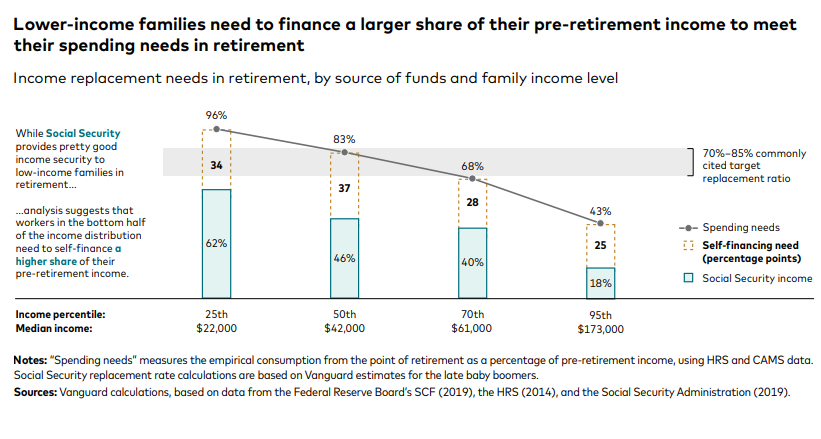How To Calculate Your Current Expected Retirement Income In 8 Easy Steps

Retirement is something we all look forward to, but to retire comfortably without stress or worry, we should have a clear understanding of how much retirement income we will have available to us.
In the US, traditionally retirement funding is intended to come from 3 sources. It’s called the 3-legged stool of retirement income and includes:
- Social Security
- Employer based Pension or 401K plan
- Personal savings/investments
Social Security and your employer plan are not designed to fully fund your retirement if you are looking to even maintain your cost of living, let alone increase it. Even personal ROTH and IRA accounts have limits on the amount you can invest each year. This is why it's important to understand your retirement income gap, and then fill it before it’s too late to do so comfortably.
Your retirement income gap is the difference between your desired retirement income, see my previous article for the easy step by step to do this, and your estimated current retirement income.
Desired Retirement Income - Current Expected Retirement Income = Retirement Income Gap
Today’s article will walk you through how to calculate your current expected retirement income, so you can then calculate your retirement income gap.
Step 1: Calculate Your Social Security Benefits
Social Security is a government program that provides retirement benefits to eligible workers. You become eligible once you have paid into social security for at least 40 quarters. To find out your expected social security retirement income, create your My Social Security account here. Once completed scroll down to the Plan My Retirement section and select your retirement age to see how much you will receive.
Please note that given current US debt levels these numbers are subject to change and may either be downgraded or pushed out to older years to keep the program solvent.
Step 2: Understand Your Pension Benefits
If you are lucky enough to have a pension plan, you should be able to view your expected retirement monthly benefit by age either on your annual pension statement or in your online account. If not you can contact your plan administrator and ask. Your pension benefits will depend on the type of plan you have, your years of service, and your salary history.
Step 3: Learn Your Retirement Account Benefits
For 401K, 403b, IRA, ROTH and other retirement accounts, most plans will provide a tool that estimates monthly or annual retirement income for you. If this is not provided automatically, reach out to your fund administrator and request an illustration, provide them with your anticipated age/year of retirement. Make note of whether the distributions are taxable or non-taxable.
Step 4: Estimate Your Investment Income
Should you have money in other investment accounts such as mutual or index funds and even brokerage accounts, you can use the SEC’s Compound Interest Calculator to work out what the expected future balance will be at your retirement age. From there you can calculate your expected retirement income from that balance. As a rule of thumb, 4% per year will have the funds last for 20 years (accounting for average historic market fluctuations), however these days due to longer life expectancy 3% is a safer number to use.
Step 5: Calculate Property Rental Income
To calculate future property investment property income use the following steps:
A. Current monthly rental income x 12;
B. Multiply A. by 1 + expected annual rental growth rate for your area ^number of years until retirement;
C. Multiple B. by 1 - your expected vacancy rate this is your expected gross annual property income.
D. Subtract from C. your estimated annual operating expenses such as HOA fees, insurance, management fees, utilities, trash, water, gardening, property taxes etc.
E. From D. you also need to deduct your annual estimated maintenance and capital repairs costs.
You now have your estimated Property Rental income.
Step 6: Other Sources of Income
Don’t forget to include other sources of income too. Some of you may already have purchased annuities or cash value life insurance policies designed to provide retirement income. Others may expect income from trusts, business income or other sources. Make sure to note all of these for your retirement income calculations.
Step 7: Add Up Your Total Retirement Income
Once you have estimated your Social Security benefits, pension, investment income, rental properties and other sources of income, add them all together to determine your expected total retirement income. This will give you a good idea of how much money you will have available to you in retirement based on current plans.
Step 8: Compare Your Retirement Income to Your Retirement Expenses
Your final step is to compare your expected retirement income to the desired retirement income that we calculated previously. Make sure you factored inflation into your desired retirement expenses in the first step or you may find your income calculations won’t be enough when you get there.
If your retirement income is less than your retirement expenses, this is your retirement income gap.
Next step is to create plans to fill or reduce that income gap. That’s what we’ll tackle in my next article.






